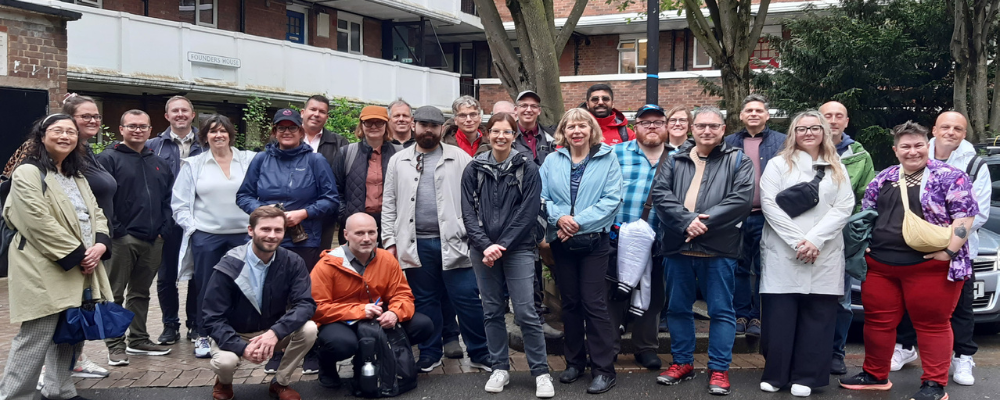
Affordable housing and homelessness in London, England
25 Jul 2024
Guest Author
By Nick Falvo, PhD
I recently helped organize a study tour focused on affordable housing and homelessness in London, England. A partnership with the Chartered Institute of Housing Canada and the Canadian Housing and Renewal Association, we toured 10 sites over a five-day period. Our group consisted of 30 participants—mostly Canadians from the non-profit sector and government.
Here are 10 things to know:
1. There has been increased awareness and concern in England about the quality of existing social housing units. This was brought into sharp focus by the tragic fire at Grenfell Tower in 2017, during which 70 people died. Over the past few years, there’s also been a social media campaigner who’s been very effective at drawing awareness to quality concerns in social housing throughout England.
2. Similarly, customer relations with existing social housing tenants is growing as an issue. Plentific, an Uber-style solution to home repairs and maintenance, may be part of the solution. They connect contractors to units, speeding up work orders. Plentific offers a software platform that allows tenants to see progress on work orders as the work unfolds and also to rate the quality of the work, much as an Uber customer can watch the status of their ride and provide a driver rating.
3. New immigrants are being scapegoated. Many people experiencing visible homelessness in London do not speak English, as very few of them are from the United Kingdom (UK). In fact, about 80% of London’s rough sleepers today are not from the UK, and this makes it challenging to get funding support to address it. This is often referred to as “migration homelessness.”
4. Mixed tenure is very much the new direction for non-profit housing providers. Poplar HARCA, for example, has acquired housing stock over the years via transfers from what used to be council housing (i.e., public housing). It initially had 80% social housing. Now it’s headed towards 50% (but not by reducing total social housing stock – in fact, it is increasing total social housing stock, but not as quickly as other types). One advantage of a mixed model is that it allows for cross subsidy (i.e., rental income from some units help to subsidized rent in other units).
5. Joint ventures can help address housing affordability. Peabody, a not-for-profit housing association, lacks in-house construction expertise; they therefore like to enter joint ventures with private developers such as Mount Anvil. With some of the units created, leases are sold to private homeowners; but Peabody then takes the affordable homes back after construction is complete, at which point the joint venture dissolves. Technically, Peabody buys the affordable units from the joint venture. And on the private units, Peabody gets 50% of the profits on the sale to private homeowners.
6. Some of London’s non-profit housing providers are massive in size. L&Q Housing has more than 108,000 units. Of these, 64,000 units are social renting (i.e., very low rent). L&Q has over 4,000 employees, roughly 450 of whom are on the development team. Due largely to its size, L&Q Housing is able to borrow on the bond market, securing lower interest rates than through conventional lending.
7. Yet, emergency shelters in London tend to be much smaller than those in major North American cities. Over the years, several large ones were closed down; others were repurposed in order to offer more self-contained apartment-style accommodation (this was accelerated during the COVID pandemic). London tends to not to see more than 100 people in any one emergency shelter.
8. London has several client-level databases. In-Form is England’s main client-level database system, used by 335 organizations (there are 27,000 licenses, representing 50% of every staff person in England’s homelessness sector). CHAIN, intended for rough sleeping, is used by all 35 of London’s outreach teams. StreetLink is also for rough sleeping, but features an app allowing members of the general public to ‘call in’ when they see someone sleeping rough.
9. Human trafficking is a major issue in London’s homelessness sector. For example, ‘aggressive begging’ is sometimes organized by gangs, and the passports of some of the panhandlers are sometimes kept in order to hold them ransom. To help address this problem, The Passage has an Anti-Slavery Team, providing support to survivors of modern slavery who are homeless or at risk of
homelessness in Westminster (central London).
10. St Mungo’s coordinates some innovative prison ‘in reach.’ St Mungo’s tries to both prevent the eviction of recently- incarcerated inmates and line up housing (and income assistance) for persons about to be released from prison. The organization is now in 10 London Estate prisons. They have about 30 FTE staff working on this; they also subcontract a further 15 positions to a partner agency. Staff focus on the last eight weeks of an inmate’s sentence, in part because there is not much point in trying to find a person housing before that.
In sum. This blog post provides an overview of a five-day study tour, organized in partnership with the Chartered Institute of Housing Canada and the Canadian Housing and Renewal Association. Our next study tour will take place in Helsinki, Finland, September 22-26, 2025 (to remain in the loop on developments related to that study tour, please reach out to Mel Willerth at mel@chra-achru.ca).
I wish to thank Bob Regnier, Sylvia Regnier and Annick Torfs for assistance with this blog post, which originally appeared at the home page of Nick Falvo Consulting: https://nickfalvo.ca/.
